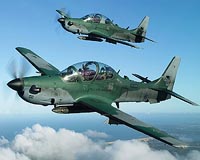| . |  |
. |
Canberra, Australia (UPI) Mar 26, 2009 Australia has signed a $467 million contract with the U.S. Army Security Assistance Command to buy seven CH-47F Chinook helicopters, two simulators and associated spares. The Defense Materiel Organization, the procurement arm of the Australian military, signed the deal for the aircraft that will replace six Boeing CH-47D Chinooks. The helicopters are operated by C Squadron of the 5th Aviation Regiment based in Townsville, on the northeast coast of Australia. The first two aircraft will enter service in 2014, with all seven in service with the Australian military by 2017, the Minister for Defense Personnel, Materiel and Science Greg Combet said. "The CH-47D fleet is providing outstanding support to the (Australian military), particularly in Afghanistan, and this acquisition of seven new CH-47F Chinook helicopters will strengthen our ability to support our soldiers in the future," he said. The CH-47Fs will have minor Australian-specific mission-equipment enhancements including crash-worthy crew and passenger seating, fitment of mini guns and underfloor ballistic protection. "However, the primary aircraft elements will remain consistent with the U.S. Army fleet so we can leverage the benefits of their large fleet for engineering and other support," Combet said. The U.S. Army was operating 48 of the F version when Boeing announced in 2008 a further contract, a five-year deal worth nearly $5 billion for 191 aircraft plus an option on 24 more. Combet gave no details of the mini gun to be used on the Australia aircraft but the weapons is usually a 7.62mm, multi-barrel machine gun with a rate of fire up to 6,000 rounds per minute. The weapon with its Gatling-style rotating barrels has an external electrical power source, the main defining characteristic of the gun. There are similarly designed weapons but they use larger shells, such as General Electric's 20mm M61 Vulcan. The Chinook contract was arranged through the U.S. government's Foreign Military Sales program and signed at a ceremony at the Australian Embassy in Washington. The purchase is phase 5C of the major helicopter upgrade and management plan Project AIR 9000 as set out in the government's Defense Capability Plan 2009. The focus of Project AIR 9000 is the efficient management of all Australian military helicopter fleets in a multitude of roles. These include air mobile, armed reconnaissance, medium lift, maritime support, anti-submarine and warfare, training and support to special forces. The first four phases of the plan includes buying additional troop-lift helicopters, the MRH-90. A Seahawk capability assurance program and a replacement for the Black Hawk helicopter with MRH-90s are a part of the fist phases of the plan. Still to come are replacements for the maritime support helicopters, a new helicopter aircrew training system and the provision of at least 24 new anti-submarine warfare/anti-surface warfare helicopters. Project AIR 9000 has a strong made-in-Australia aspect for spare parts and services agreements. "Australian industry will have the opportunity to incorporate the Australian-specific enhancements and to support the new helicopters as part of through-life support arrangements," Combet said. The original twin-engine, tandem-rotor Chinook was first produced by Boeing-Vertol in the early 1960s but is now produced by Boeing Integrated Defense Systems. The D version with its triple-hook cargo system was first produced in 1979 and has as top speed of just more than 160 mph. It can carry up to 26,000 pounds of external cargo such bulldozers and 40-foot containers at more than 155 mph. The aircraft has been particularly useful in the mountains of Afghanistan where high altitudes and temperatures limit use of the UH-60 Black Hawk. The first F versions, an upgraded D model, rolled out of the Boeing facility in Ridley Park, Pa., in mid 2006. The F extends the service life of the Chinook class beyond 2030. Among the upgrades are 4,868 shaft horsepower Honeywell engines that give the aircraft a top speed of 175 mph with a payload of more than 21,000 pounds. Improved avionics include a Rockwell Collins Common Avionics Architecture System cockpit and a BAE Systems Digital Advanced Flight Control System. A major base for Australia's helicopters is Townsville, a sea-side city of 170,000 people that during World War II hosted more than 50,000 U.S. and Australian troops and air crew.
Share This Article With Planet Earth
Related Links The Military Industrial Complex at SpaceWar.com Learn about the Superpowers of the 21st Century at SpaceWar.com
 Brazil fighter jet bid results to come after Easter
Brazil fighter jet bid results to come after EasterRio De Janeiro (AFP) March 25, 2010 Brazilian Defense Minister Nelson Jobim said Thursday that the winner of a multi-billion-dollar contract to supply the Brazilian air force would not be announced until after Easter, April 4. France's Dassault with its Rafale fighter, Sweden's Saab with the Gripen NG aircraft and US-based Boeing with the F/A-18 Super Hornet are competing to supply Brazil's air force with 36 new fighter jets. ... read more |
|
| The content herein, unless otherwise known to be public domain, are Copyright 1995-2010 - SpaceDaily. AFP and UPI Wire Stories are copyright Agence France-Presse and United Press International. ESA Portal Reports are copyright European Space Agency. All NASA sourced material is public domain. Additional copyrights may apply in whole or part to other bona fide parties. Advertising does not imply endorsement,agreement or approval of any opinions, statements or information provided by SpaceDaily on any Web page published or hosted by SpaceDaily. Privacy Statement |